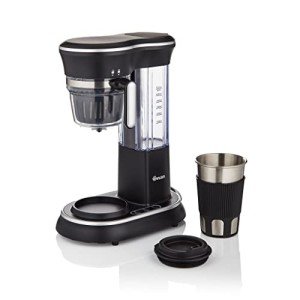The Ultimate Guide to Whole Bean Coffee Machines
In an age where coffee enthusiasts have actually become increasingly critical, the choice of a coffee machine has become more critical than ever. Whole bean coffee machines have actually become a preferred amongst major coffee drinkers, permitting them to extract the freshest tastes from coffee beans. This article digs into the intricacies of whole bean coffee machines, exploring their features, benefits, and considerations for the devoted coffee lover.
What is a Whole Bean Coffee Machine?
A whole bean coffee machine is designed to grind coffee beans simply before brewing, ensuring optimum freshness and taste extraction. Unlike conventional coffee machine that count on pre-ground coffee, these machines include a grinder, which permits the user to choose the grind size matched to their developing technique, from espresso to French press.
Advantages of Whole Bean Coffee Machines
- Freshness: The primary advantage of using whole beans is that they retain their flavor longer than pre-ground coffee. Grinding Fresh Coffee Machine before developing protects the fragrant oils that contribute to the overall flavor profile.
- Personalization: Many whole bean machines enable users to change grind settings, water temperature level, and brewing time to create an individualized cup of coffee that fulfills private choices.
- Quality Control: Whole bean coffee machines empower users to pick premium beans from various sources, making it much easier to explore unique taste profiles.
- Versatility: These machines deal with various developing methods, making it possible for users to craft espresso, drip coffee, or specialized brews with ease.
- Convenience: Integrated mills simplify the coffee-making process, reducing the need for extra devices and decreasing cleanup.
Secret Features to Consider
When picking a whole bean coffee machine, a number of functions should be considered:
Grinder Type:
- Burr vs. Blade: Burr grinders use a more consistent grind, which is crucial for consistency in flavor, whereas blade mills tend to produce unequal grinds.
- Brew Method Compatibility: Ensure the machine can accommodate the developing technique preferred (e.g., espresso, pour-over, French press).
- Capacity: Consider the hopper size for holding coffee beans; larger capabilities indicate less frequent refilling.
- User Interface: Look for machines with user-friendly controls, enabling users of all ability levels to run them quickly.
- Upkeep: Machines that are simple to tidy and preserve will save time and guarantee the longevity of the gadget.
- Product Quality: Stainless steel and top-quality plastic offer toughness, while machines with glass components tend to be less durable.
Popular Whole Bean Coffee Machines
| Brand name | Model | Mill Type | Capacity (Cups) | Features | Cost Range (₤) |
|---|---|---|---|---|---|
| Breville | BES870XL Barista Express | Burr | 8 | Espresso machine, steam wand | 600 - 700 |
| De'Longhi | EC702 | Pump | 10 | Double boiler system, stainless-steel | 300 - 400 |
| Cuisinart | DCC-3200P1 | Blade | 14 | 24-hour programmable, drip coffee | 50 - 100 |
| Rancilio | Silvia | Burr | 2 | Expert feel, steam power | 700 - 800 |
| Hamilton Beach | 49980A | Blended | 2 | Single-serve, versatile developing | 30 - 50 |
How to Make one of the most Out of Your Whole Bean Coffee Machine
To accomplish the very best results with a whole bean coffee machine, think about the following ideas:
- Quality Beans: Always pick top quality, fresh beans that suit your taste.
- Grind Size: Adjust the grind size based upon the brewing approach. Finer grinds are appropriate for espresso, while coarser grinds work better for French press.
- Brewing Temperature: Water temperature need to generally be in between 195 ° F and 205 ° F (90 ° C -96 ° C) for optimum extraction.
- Water Quality: Use filtered water for the very best taste and to prolong the machine's life-span.
- Upkeep Schedule: Regularly tidy the mill and machine to avoid residue accumulation and ensure consistent efficiency.
Frequently Asked Questions about Whole Bean Coffee Machines
1. Is a whole bean coffee machine worth the investment?
Yes, if you value the freshness and flavor of your coffee, investing in a whole bean coffee machine is beneficial. It enables a richer and more fragrant cup of coffee compared to pre-ground alternatives.
2. How do I tidy my whole bean coffee machine?
Many machines come with cleaning guidelines. Generally, you'll require to get rid of the grinder, clean the hopper, and run a cleaning cycle with water. Use brushes specifically designed for this function.
3. Can I utilize pre-ground coffee in a whole bean machine?
The majority of whole bean coffee machines are specifically designed for whole beans; however, some might enable you to use pre-ground coffee. Seek advice from the producer's standards.
4. What is Coffee Bean Machine for espresso?
A fine grind is generally preferred for espresso. However, experimentation can help discover the best grind size that matches your taste choices.
5. How often should I change the coffee beans?
For ideal freshness, it is encouraged to utilize coffee beans within 2 weeks of opening after they have been roasted. Store them in an airtight container far from light and moisture.
A whole bean coffee machine can raise the coffee experience, offering freshness, customization, and superior flavor. With many choices offered, possible purchasers can find a machine that fits their lifestyle and coffee choices. By considering the previously mentioned features, pointers for optimization, and keeping a consistent cleaning routine, users can appreciate every cup of newly brewed, fragrant coffee for many years to come. Whether for personal use or entertaining guests, purchasing a whole bean coffee machine is a step towards coffee perfection.

